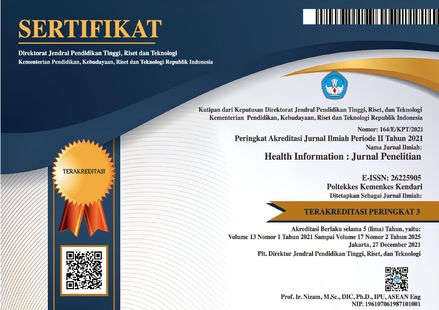Overview ot the Nutritional Status of Toddlers Aged 0-59 Months in the Working Area if The Bandarharjo Community Health Center, Semarang City
DOI:
https://doi.org/10.36990/hijp.v16i2.1487Keywords:
Toodlers, Body Mass Index, Nutritional StatusAbstract
The health of children under five years of age is an important factor for the survival of future generations, so it is important to assess the nutritional status of toddlers on an ongoing basis to determine the nutritional status of toddlers. This study aims to describe the nutritional status of toddlers aged 0-59 months in the working area of ??the Bandarharjo Community Health Center, Semarang City. The research method used is descriptive and chi-square correlation test analysis. This research sample consisted of 360 toddlers who were selected using purposive sampling techniques. Nutritional status is measured by measuring body weight and height, then classified using body mass index (BMI) according to WHO standards.
The research results show that the prevalence of nutritional status of children under five in the Bandarharjo area varies significantly. A total of 61.7% of toddlers aged 2 - 5 years, 59.7% were male, 73.3% had normal nutritional status (TB/U), 75.8% had normal nutritional status (WW/U), 74, 4% normal nutritional status (WW/TB), 93.1% good nutritional status (LILA), and 85.3% normal nutritional status (head circumference). And there is a significant relationship between baby age, baby gender, parents' occupation and religion on nutritional status (p<0.001) based on TB/U, BB/U, BB/TB and Lila. Conclusion: baby's age, baby's gender, parents' occupation, and religion have a significant relationship with the nutritional status of toddlers based on TB/U, BB/U, BB/TB and Lila indicators. Considering the importance of regular nutritional monitoring, it is recommended that health service facilities continue to carry out regular evaluations of the nutritional status of toddlers to detect and prevent nutritional problems as early as possible.
References
Agbadi, P., Urke, H.B. and Mittelmark, M.B. (2017) ‘Household Food Security and Adequacy of Child Diet in the Food Insecure Region North in Ghana’, Plos One, 12(5). Available at: https://doi.org/https://doi.org/10.1371/journal.pone.0177377.
Akbar, W.A. and Rachmat, H.H. (2018) ‘Rancang Bangun Sistem Pengukur Massa Tubuh dan Panjang Badan Elektronik Terintegrasi untuk Evaluasi Gizi Balita’, ELKOMIKA: Jurnal Teknik Energi Elektrik, Teknik Telekomunikasi, & Teknik Elektronika, 6(1), p. 125. Available at: https://doi.org/10.26760/elkomika.v6i1.125.
Anggraeni, L.D., Toby, Y.R. and Rasmada, S. (2022) ‘Analysis of Nutrient Intake on Nutritional Status of Under Five Year Children’, Faletehan Health Journal, 8(2). Available at: https://doi.org/https://doi.org/10.33746/fhj.v8i02.191.
Anggraeni, Z.E.Y. et al. (2020) ‘Hubungan Berat Badan Lahir, Panjang Badan Lahir dan Jenis Kelamin dengan kejadian stunting’, The Indonesian Journal of Health Science, 12(2), pp. 158–168. Available at: https://doi.org/https://doi.org/10.32528/ijhs.v12i1.4856.
Banudi, L. et al. (2024) ‘Kajian Analisis Pemberian Makanan Tambahan Berbahan Lokal: Percepatan Penurunan Stunting di Provinsi Sulawesi Tenggara Tahun 2023’, Health Information: Jurnal Penelitian, 16(1). Available at: https://doi.org/10.36990/hijp.v16i1.1436.
Davidson, S.M., Khomsan, A. and Riyadi, H. (2020) ‘Status gizi dan perkembangan anak usia 3-5 tahun di Kabupaten Bogor’, Jurnal Gizi Indonesia (The Indonesian Journal of Nutrition), 8(2), pp. 143–148. Available at: https://doi.org/10.14710/jgi.8.2.143-148.
Dinas Kesehatan Provinsi Jawa Tengah (2022) Data Profil Kesehatan Jawa Tengah Tahun 2022, Kemkes.go.id. Semarang. Available at: https://www.kemkes.go.id/downloads/resources/download/pusdatin/profil-kesehatan-indonesia/Profil-Kesehatan-2021.pdf.
Direktorat Gizi Masyarakat (2019) Petunjuk Teknis Sistem Informasi Gizi Terpadu (Sigizi Terpadu). Available at: https://sigiziterpadu.kemkes.go.id/Login_Sisfo/Assets/Panduan_Sigizi_ Terpadu.Pdf.
Dungga, E.F., Ibrahim, S.A. and Suleman, I. (2022) ‘No Title The Relationship Of Parents’ Education And Employment With The Nutritional Status Of The Child’, Jambura Jurnal, 4(3). Available at: http://ejurnal.ung.ac.id/index.php/jjhsr.
Harjatmo (2017) Penilaian Status Gizi?: Bahan Ajar Gizi. Jakarta: Kementrian Kesehatan Republik Indonesia.
Hartono, H., Widjanarko, B. and EM, M.S. (2017) ‘Hubungan perilaku Keluarga Sadar Gizi (KADARZI) dan Perilaku Hidup Bersih Sehat (PHBS) pada tatanan rumah tangga dengan status gizi balita usia 24-59 bulan’, Jurnal Gizi Indonesia (The Indonesian Journal of Nutrition), 5(2), pp. 88–97. Available at: https://doi.org/10.14710/jgi.5.2.88-97.
Kemenkes RI (2020) Buku Saku Pencegahan dan Tata Laksana Gizi Buruk Pada Balita di Layanan Rawat Jalan Bagi Tenaga Kesehatan, Kemenkes RI: Jakarta. Available at: https://gizikia.kemkes.go.id/assets/file/pedoman/tatalaksana-gibur.pdf.
Kemenkes RI (2022) Profil Kesehatan Indonesia 2021, Pusdatin.Kemenkes.Go.Id. Jakarta: Kementerian Kesehatan Republik Indonesia. Available at: https://www.kemkes.go.id/app_asset/file_content_download/Profil-Kesehatan-Indonesia-2021.pdf.
Kementrian Kesehatan Republik Indonesia (2020) Rencana Aksi Kegiatan Direktorat Gizi Masyarakat Tahun 2020-2025. Jakarta.: Kementrian Kesehatan Republik Indonesia.
Kurniawati, N. and Yulianto, Y. (2022) ‘Pengaruh Jenis Kelamin Balita, Usia Balita, Status Keluarga Dan Pendapatan Keluarga Terhadap Kejadian Pendek (Stunted) Pada Balita Di Kota Mojokerto’, Pengembangan Ilmu dan Praktik Kesehatan, 1(1), pp. 76–92. Available at: https://doi.org/10.56586/pipk.v1i1.192.
Langridge, F.C. et al. (2023) ‘Investigating the health status of primary school children in Tonga: Lessons learnt and reflections on field work in the Pacific Islands’, Journal of Paediatrics and Child Health, 59(6), pp. 781–785. Available at: https://doi.org/10.1111/jpc.16417.
Oktaviana, F. et al. (2020) ‘Early Detection of the Risk of Stunting in Pregnant Women and Its Recommendations’, 2020 International Symposium on Community-Centric Systems, CcS 2020, pp. 0–5. Available at: https://doi.org/10.1109/CcS49175.2020.9231464.
Par’i, H.M. (2014) Penilaian Status Gizi. Jakarta: EGC. Available at: https://egcmedbooks.com/buku/detail/2626/penilaian-status-gizi-ed2.
Rasmaniar, R. et al. (2022) ‘Pendidikan Teman Sebaya melalui PemberdayaanKader Posyandu Remaja terhadap Pengetahuan,Sikap, dan Perilaku Remaja tentang ManfaatGizi dalam Pencegahan Stunting: Penelitian KuasiEksperimen’, ealth Information: Jurnal Penelitian, 14(1). Available at: https://doi.org/https://doi.org/10.36990/hijp.v14i1.498.
Solihin, R.D.M., Anwar, F. and Sukandar, D. (2013) ‘Motorik Pada Anak Usia Prasekolah (Relationship Between Nutritional Status, Cognitive Development, and Motor Development in Preschool Children)’, Penelitian Gizi dan Makanan, 36(1), pp. 62–72. Available at: https://doi.org/https://dx.doi.org/10.22435/pgm.v36i1.3396.62-72.
Yustiari et al. (2023) ‘Pengayaan Pengetahuan dan Sikap Kader Kesehatan Masyarakat melalui Inovasi ProgramPendidikan Pencegahan Stunting’, Health Information: Jurnal Penelitian, 15(1). Available at: https://doi.org/https://doi.org/10.36990/hijp.v15i1.730.
Downloads
Published
How to Cite
Issue
Section
Citation Check
License
Copyright (c) 2024 Nursita Istiqomah, Melyana Nurul Widyawati, Kurnianingsih (Author)

This work is licensed under a Creative Commons Attribution-ShareAlike 4.0 International License.
Authors retain copyright and grant the journal right of first publication with the work simultaneously licensed under a Creative Commons Attribution-ShareAlike 4.0 International License that allows others to share the work with an acknowledgment of the works authorship and initial publication in this journal and able to enter into separate, additional contractual arrangements for the non-exclusive distribution of the journals published version of the work (e.g., post it to an institutional repository or publish it in a book).
Funding data
-
Ministry of Health of the Republic of Indonesia
Grant numbers HK.02.02/V/18753/2021.
















